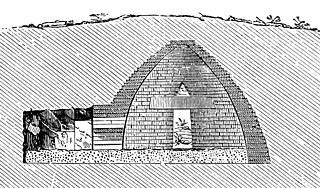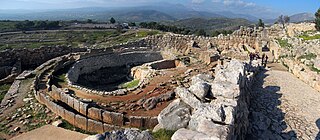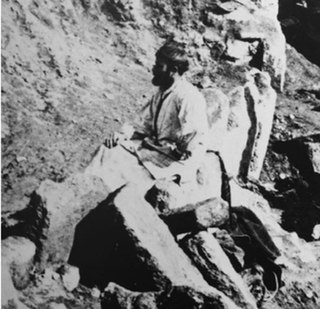


A shaft tomb or shaft grave is a type of deep rectangular burial structure, similar in shape to the much shallower cist grave, containing a floor of pebbles, walls of rubble masonry, and a roof constructed of wooden planks. [1]



A shaft tomb or shaft grave is a type of deep rectangular burial structure, similar in shape to the much shallower cist grave, containing a floor of pebbles, walls of rubble masonry, and a roof constructed of wooden planks. [1]
The practice of digging shaft tombs was a widespread phenomenon with prominent examples found in Mycenaean Greece; in Bronze Age China; and in Mesoamerican Western Mexico. [2]
In the Neolithic period Epirus was populated by seafarers along the coast and by shepherds and hunters from the southwestern Balkans who brought with them the Proto-Greek language. These people buried their leaders in large mounds containing shaft graves. Similar burial chambers were subsequently used by the Mycenaean civilization, suggesting that the founders of Mycenae may have come from Epirus and central Albania. Epirus itself remained culturally backward during this time, but Mycenaean remains have been found at two religious shrines of great antiquity in the region: the Oracle of the Dead on the Acheron River, familiar to the heroes of Homer's Odyssey, and the Oracle of Zeus at Dodona, to whom Achilles prayed in the Iliad. [3]
Mycenaean shaft graves originated and evolved from rudimentary Middle Helladic cists, tumuli, and tholos tombs with features derived from Early Bronze Age traditions developed locally in mainland Bronze Age Greece 16th century BCE. [4] Middle Helladic burials would ultimately serve as the basis for the royal Shaft Graves containing a variety of grave goods, which signified the elevation of a native Greek-speaking royal dynasty whose economic power depended on long-distance sea trade. [5]
The depth of Mycenaean shaft tombs would range from 1 to 4 m (3 to 13 ft) with a mound constructed for each grave and stelae erected. [6] Archaeological examples include Grave Circle A and Grave Circle B.
Shaft graves were used by elites from the Shang dynasty (or Yin dynasty) during the Bronze Age 1200 BCE of northern China. [2]
The Western Mexico shaft tomb tradition or shaft tomb culture refers to a set of interlocked cultural traits found in the present day western Mexican states of Jalisco, Nayarit, and, to a lesser extent, Colima to its south, roughly dating to the period between 300 BCE and 400 CE. An example is the La Campana archaeological site of the Capacha and subsequent cultures.

Aegean civilization is a general term for the Bronze Age civilizations of Greece around the Aegean Sea. There are three distinct but communicating and interacting geographic regions covered by this term: Crete, the Cyclades and the Greek mainland. Crete is associated with the Minoan civilization from the Early Bronze Age. The Cycladic civilization converges with the mainland during the Early Helladic ("Minyan") period and with Crete in the Middle Minoan period. From c. 1450 BC, the Greek Mycenaean civilization spreads to Crete, probably by military conquest. The earlier Aegean farming populations of Neolithic Greece brought agriculture westward into Europe before 5000 BC.

Mycenae is an archaeological site near Mykines in Argolis, north-eastern Peloponnese, Greece. It is located about 120 kilometres south-west of Athens; 11 kilometres north of Argos; and 48 kilometres south of Corinth. The site is 19 kilometres inland from the Saronic Gulf and built upon a hill rising 900 feet above sea level.

A beehive tomb, also known as a tholos tomb, is a burial structure characterized by its false dome created by corbelling, the superposition of successively smaller rings of mudbricks or, more often, stones. The resulting structure resembles a beehive, hence the traditional English name.

Mycenaean Greece was the last phase of the Bronze Age in ancient Greece, spanning the period from approximately 1750 to 1050 BC. It represents the first advanced and distinctively Greek civilization in mainland Greece with its palatial states, urban organization, works of art, and writing system. The Mycenaeans were mainland Greek peoples who were likely stimulated by their contact with insular Minoan Crete and other Mediterranean cultures to develop a more sophisticated sociopolitical culture of their own. The most prominent site was Mycenae, after which the culture of this era is named. Other centers of power that emerged included Pylos, Tiryns, and Midea in the Peloponnese, Orchomenos, Thebes, and Athens in Central Greece, and Iolcos in Thessaly. Mycenaean settlements also appeared in Epirus, Macedonia, on islands in the Aegean Sea, on the south-west coast of Asia Minor, and on Cyprus, while Mycenaean-influenced settlements appeared in the Levant and Italy.

The Treasury of Atreus or Tomb of Agamemnon is a large tholos or beehive tomb constructed between 1300 and 1250 BCE in Mycenae, Greece.
Greek is an Indo-European language, the sole surviving descendant of the Hellenic sub-family. Although it split off from other Indo-European languages around the 3rd millennium BCE, it is first attested in the Bronze Age as Mycenaean Greek. During the Archaic and Classical eras, Greek speakers wrote numerous texts in a variety of dialects known collectively as Ancient Greek. In the Hellenistic era, these dialects underwent dialect levelling to form Koine Greek which was used as a lingua franca throughout the eastern Roman Empire, and later grew into Medieval Greek. For much of the period of Modern Greek, the language existed in a situation of diglossia, where speakers would switch between informal varieties known as Dimotiki and a formal one known as Katharevousa. Present-day Modern Standard Greek is largely an outgrowth of Dimotiki, with some features retained from Katharevousa.

Helladic chronology is a relative dating system used in archaeology and art history. It complements the Minoan chronology scheme devised by Sir Arthur Evans for the categorisation of Bronze Age artefacts from the Minoan civilization within a historical framework. Whereas Minoan chronology is specific to Crete, the cultural and geographical scope of Helladic chronology is confined to mainland Greece during the same timespan. Similarly, a Cycladic chronology system is used for artifacts found in the Aegean islands. Archaeological evidence has shown that, broadly, civilisation developed concurrently across the whole region and so the three schemes complement each other chronologically. They are grouped together as "Aegean" in terms such as Aegean art and, rather more controversially, Aegean civilization.

The Mask of Agamemnon is a gold funerary mask discovered at the Bronze Age site of Mycenae in southern Greece. The mask, displayed in the National Archaeological Museum of Athens, has been described by the historian Cathy Gere as the "Mona Lisa of prehistory".

Christos Tsountas was a Greek classical archaeologist. He is considered a pioneer of Greek archaeology and has been called "the first and most eminent Greek prehistorian".
The Silver Siege Rhyton is a silver vessel discovered in Shaft Grave IV of Grave Circle A at Mycenae and is dated to c. 1600–1500 BCE, or during the Late Helladic I period. The rhyton was likely used for the transportation of libation for use in sacred ritual and is so named for its relief depicting an attack on a fortified town. The abundance of precious metalwork and weaponry both votive and practical discovered in Shaft Grave IV suggests that it was the burial place of a warrior chieftain or a member of his family.

A Mycenaean chamber tomb is the type of chamber tomb that was built in Mycenaean Greece. Mycenaean chamber tombs originated in Messenia at the end of the Middle Helladic period, and were built and used throughout the Late Bronze Age across the Aegean area.

Bush Barrow is a site of the early British Bronze Age Wessex culture, at the western end of the Normanton Down Barrows cemetery in Wiltshire, England. It is among the most important sites of the Stonehenge complex, having produced some of the most spectacular grave goods in Britain. It was excavated in 1808 by William Cunnington for Sir Richard Colt Hoare. The finds, including worked gold objects, are displayed at Wiltshire Museum in Devizes.

The Archaeological Museum of Nafplio is a museum in the town of Nafplio of the Argolis region in Greece. It has exhibits of the Neolithic, Chalcolithic, Helladic, Mycenaean, Classical, Hellenistic and Roman periods from all over southern Argolis. The museum is situated in the central square of Nafplion. It is housed in two floors of the old Venetian barracks.

Grave Circle A is a 16th-century BC royal cemetery situated to the south of the Lion Gate, the main entrance of the Bronze Age citadel of Mycenae in southern Greece. This burial complex was initially constructed outside the walls of Mycenae and ultimately enclosed in the acropolis when the fortification was extended during the 13th century BC. Grave Circle A and Grave Circle B, the latter found outside the walls of Mycenae, represents one of the significant characteristics of the early phase of the Mycenaean civilization.

Grave Circle B in Mycenae is a 17th–16th century BCE royal cemetery situated outside the late Bronze Age citadel of Mycenae, southern Greece. This burial complex was constructed outside the fortification walls of Mycenae and together with Grave Circle A represent one of the major characteristics of the early phase of the Mycenaean civilization.

There were a number of grave stelai or stelae found among the six shaft graves at Grave Circle A in the site of Mycenae. These stelai mark the burial sites of the Mycenaean dead, much like modern headstones. At least 21 stelai have been discovered from Grave Circle A, with 12 having identifiable relief sculpture. Most were upright, rectangular slabs of oolithic limestone, ranging in date from 1600 to 1500 BCE. The iconography depicted on these stelai include chariot scenes, hunting scenes, and circular and spiral designs characteristic of the Greek Mycenaean Period. Scholars argue that these scenes demonstrate the prevalence of warfare in Mycenaean culture, in addition to signifying a socially stratified society.
The archaeology of Greece includes artificial remains, geographical landscapes, architectural remains, and biofacts. The history of Greece as a country and region is believed to have begun roughly 1–2 million years ago when Homo erectus first colonized Europe. From the first colonization, Greek history follows a sequential pattern of development alike to the rest of Europe. Neolithic, Bronze, Iron and Classical Greece are highlights of the Greek archaeological record, with an array of archaeological finds relevant to these periods.
Sofia Voutsaki is Professor of Greek Archaeology at the University of Groningen and a specialist in the archaeology of the Bronze Age Aegean and classical Greece. She has directed excavations and surveys in the Argolid and at the Mycenaean site of Ayios Vasileios near Sparta, and has also published works on social change, mortuary archaeology, archaeological science, and the history of 19th- and 20th-century Greek archaeology.

Panagiotis Antoniou Stamatakis was a Greek archaeologist. He is noted particularly for his role in supervising the excavations of Heinrich Schliemann at Mycenae in 1876, and his role in recording and preserving the archaeological remains at the site.

The Tomb of Aegisthus is a Mycenaean tholos tomb located near the citadel of Mycenae, Greece. It was constructed in the Late Helladic IIA period, approximately 1510–1450 BCE, and rediscovered in the 19th century. It was first excavated by Winifred Lamb in 1922, as part of a project led by Alan Wace.